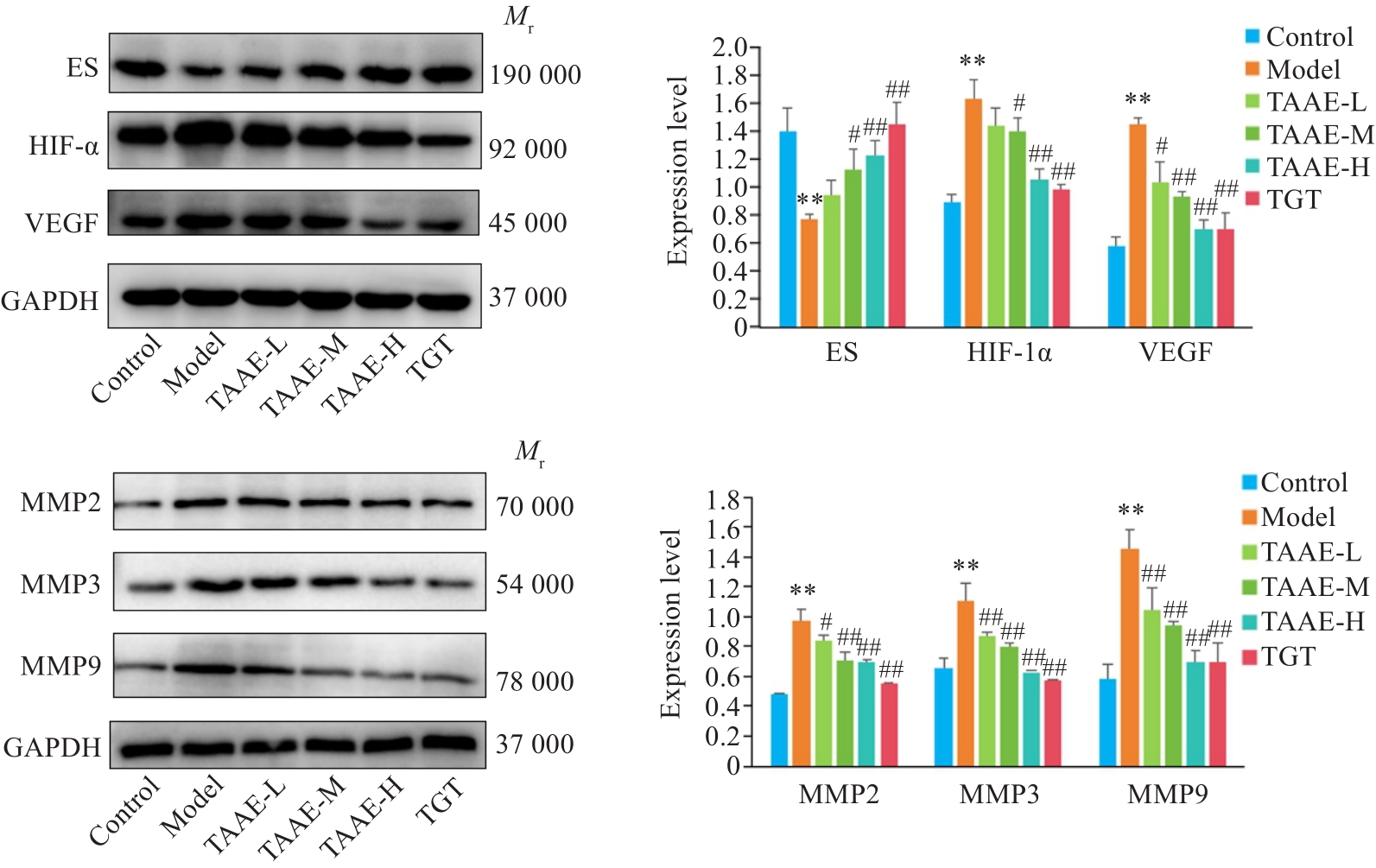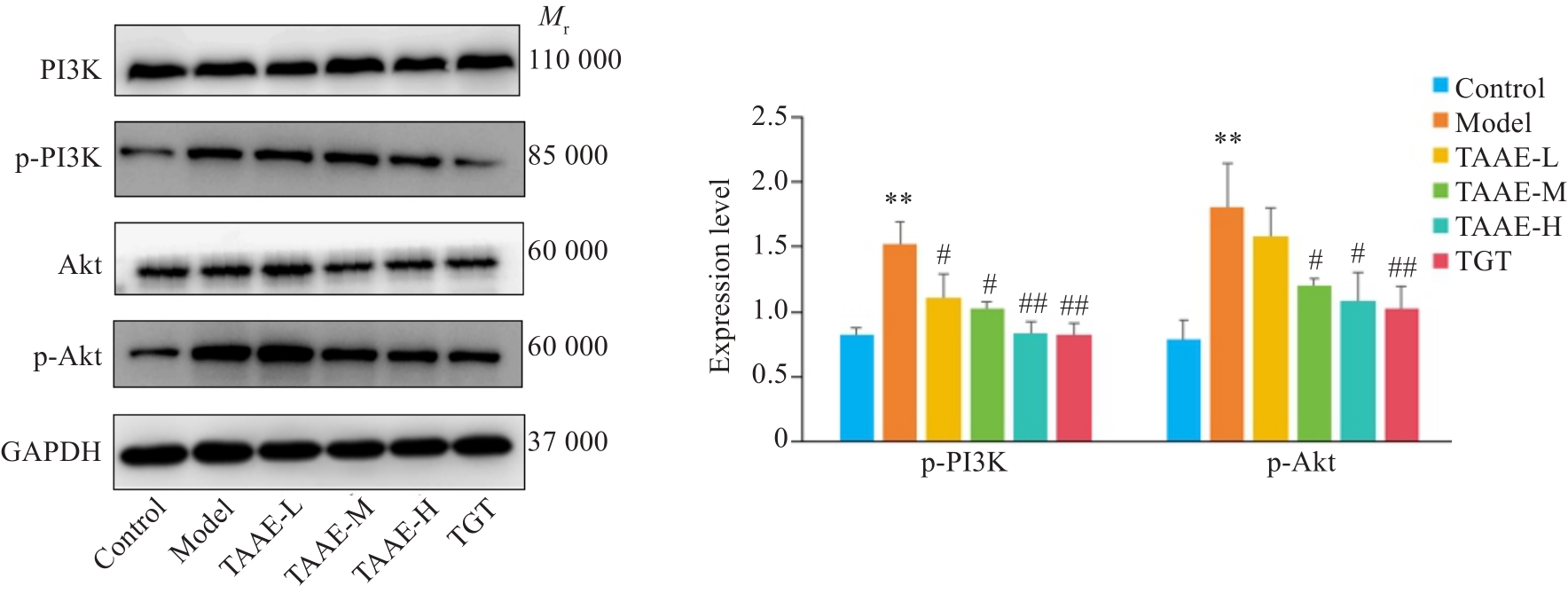Journal of Southern Medical University ›› 2024, Vol. 44 ›› Issue (8): 1582-1588.doi: 10.12122/j.issn.1673-4254.2024.08.17
Previous Articles Next Articles
Shan XIANG1,2( ), Zongxing ZHANG2,3(
), Zongxing ZHANG2,3( ), Lu JIANG2,3, Daozhong LIU2,3, Weiyi LI2,3, Zhuoma BAO2,3, Rui TIAN2, Dan CHENG2, Lin YUAN2,3(
), Lu JIANG2,3, Daozhong LIU2,3, Weiyi LI2,3, Zhuoma BAO2,3, Rui TIAN2, Dan CHENG2, Lin YUAN2,3( )
)
Received:2024-05-05
Online:2024-08-20
Published:2024-09-06
Contact:
Lin YUAN
E-mail:Xiangshan8012@126.com;376982557@qq.com;171354806@qq.com
Supported by:Shan XIANG, Zongxing ZHANG, Lu JIANG, Daozhong LIU, Weiyi LI, Zhuoma BAO, Rui TIAN, Dan CHENG, Lin YUAN. Tujia medicine Toddalia asiatica improves synovial pannus in rats with collagen-induced arthritis through the PI3K/Akt signaling pathway[J]. Journal of Southern Medical University, 2024, 44(8): 1582-1588.
Add to citation manager EndNote|Ris|BibTeX
URL: https://www.j-smu.com/EN/10.12122/j.issn.1673-4254.2024.08.17
| Score | Joint symptoms |
|---|---|
| 0 | No swelling or redness |
| 1 | Mild swelling and redness |
| 2 | Moderate swelling and redness with slight decrease in joint mobility |
| 3 | Severe swelling and redness with slight decrease in joint mobility |
| 4 | Severe redness and swelling with significant stiffness and limited joint mobility |
Tab.1 Scoring criteria for arthritis severity in rats
| Score | Joint symptoms |
|---|---|
| 0 | No swelling or redness |
| 1 | Mild swelling and redness |
| 2 | Moderate swelling and redness with slight decrease in joint mobility |
| 3 | Severe swelling and redness with slight decrease in joint mobility |
| 4 | Severe redness and swelling with significant stiffness and limited joint mobility |
| Name | Primer sequence (5'-3') |
|---|---|
| GAPDH | F:CTGGAGAAACCTGCCAAGTATG |
| R:GGTGGAAGAATGGGAGTTGCT | |
| TNF-α | F:CCCTCACACTCACAAACCACC |
| R:CTTTGAGATCCATGCCGTTG | |
| IL-1β | F:GCATCCAGCTTCAAATCTCGC |
| R:TGTTCATCTCGGAGCCTGTAGTG | |
| IL-6 | F:CCCCAATTTCCAATGCTCTCC |
| R:CGCACTAGGTTTGCCGAGTA | |
| PI3K | F:TGACAGGCACAACGACAACATC |
| R:AGGTAAGCCCTAACGCAGACAT | |
| Akt | F:CGACGTAGCCATTGTGAAGGAG |
| R:ATTGTGCCACTGAGAAGTTGTTG | |
| HIF-1α | F:CCGCCACCACCACTGATGAATC |
| R:CCGCCACCACCACTGATGAATC | |
| VEGF | F:CCGCCACCACCACTGATGAATC |
| R:CCGCCACCACCACTGATGAATC |
Tab.2 Primers sequence for RT-qPCR
| Name | Primer sequence (5'-3') |
|---|---|
| GAPDH | F:CTGGAGAAACCTGCCAAGTATG |
| R:GGTGGAAGAATGGGAGTTGCT | |
| TNF-α | F:CCCTCACACTCACAAACCACC |
| R:CTTTGAGATCCATGCCGTTG | |
| IL-1β | F:GCATCCAGCTTCAAATCTCGC |
| R:TGTTCATCTCGGAGCCTGTAGTG | |
| IL-6 | F:CCCCAATTTCCAATGCTCTCC |
| R:CGCACTAGGTTTGCCGAGTA | |
| PI3K | F:TGACAGGCACAACGACAACATC |
| R:AGGTAAGCCCTAACGCAGACAT | |
| Akt | F:CGACGTAGCCATTGTGAAGGAG |
| R:ATTGTGCCACTGAGAAGTTGTTG | |
| HIF-1α | F:CCGCCACCACCACTGATGAATC |
| R:CCGCCACCACCACTGATGAATC | |
| VEGF | F:CCGCCACCACCACTGATGAATC |
| R:CCGCCACCACCACTGATGAATC |

Fig.3 Effects of TAAE and TGT on serum levels of TNF-α, IL-6 and IL-1β in CIA rats (Mean±SD, n=10). **P<0.01 vs control group; ##P<0.01 vs model group.

Fig.5 Comparison of protein expressions in the synovial tissue of the rats in different groups (Mean±SD, n=6). **P<0.01 vs control group; #P<0.05, ##P<0.01 vs model group.

Fig.6 Comparison of expressions of pathway-related proteins in synovial tissue of rats in each group (Mean±SD, n=6). **P<0.01 vs control group; #P<0.05, ##P<0.01 vs model group.
| 1 | Neumann E, Frommer K, Diller M, et al. Rheumatoide arthritis[J]. Z Für Rheumatol, 2018, 77(9): 769-75. |
| 2 | Scott DL, Wolfe F, Huizinga TWJ. Rheumatoid arthritis[J]. Lancet, 2010, 376(9746): 1094-108. |
| 3 | Martínez A, Orozco G, Varadé J, et al. Macrophage migration inhibitory factor gene: influence on rheumatoid arthritis susceptibility[J]. Hum Immunol, 2007, 68(9): 744-7. |
| 4 | Bartok B, Firestein G S. Fibroblast-like synoviocytes: key effector cells in rheumatoid arthritis[J]. Immunol Rev, 2010, 233(1): 233-55. |
| 5 | 崔家康. 清热活血方调控外泌体miRNA干预类风湿关节炎骨破坏的机制及方药优化研究[D]. 北京: 中国中医科学院, 2020. |
| 6 | Alten R, Mischkewitz M. 2021 ACR guideline reflects changes in RA treatment[J]. Nat Rev Rheumatol, 2021, 17(9): 513-4. |
| 7 | 南奕阳. 基于TLR4/NF-κB通路探讨三百棒对CIA大鼠滑膜作用影响的机制[D] 湖北民族大学, 2019. |
| 8 | 张宗星, 江 露, 刘道忠, 等. 基于PI3K/AKT/mTOR通路的三百棒促进脂多糖诱导的RAW 264.7细胞自噬并抑制炎症[J]. 天然产物研究与开发, 2023, 35(4): 573-83. |
| 9 | 杨 丹, 孙银凤, 白 敏, 等. 基于PI3K/AKT信号通路的大黄牡丹汤对急性胰腺炎大鼠肺组织细胞凋亡及炎症反应的影响[J]. 中国中医药信息杂志, 2022, 29(7): 73-9. |
| 10 | 黄生辉, 李建华, 张玮琼, 等. 沉默TREM-2对类风湿关节炎成纤维样滑膜细胞迁移和侵袭的影响[J]. 中国病理生理杂志, 2016, 32(1): 134-9. |
| 11 | Zou L, Zhang GC, Liu LF, et al. Relationship between PI3K pathway and angiogenesis in CIA rat synovium[J]. Am J Transl Res, 2016, 8(7): 3141-7. |
| 12 | 吴朝伟, 向 珊, 向 敏, 等. 三百棒对RA大鼠关节滑膜中VEGF、MMP-3表达的影响[J]. 实用中医药杂志, 2014, 30(12). |
| 13 | 张誉丹. 基于TLR/NF-κB信号通路探讨土家族药三百棒抑制RA滑膜增殖的作用机制[D]. 恩施: 湖北民族学院, 2018. |
| 14 | 洪 岚. 基于PI3K/AKT/mTOR自噬信号通路探讨三百棒抑制MH7A细胞增殖的作用机制[D].湖北民族大学, 2022. |
| 15 | 张宗星, 江 露, 刘道忠, 等. 三百棒醇提物通过抗炎和凋亡作用减轻CIA大鼠的关节炎[J]. 中国中药杂志, 2023, 48(8): 2203-11. |
| 16 | McInnes IB, Schett G. The pathogenesis of rheumatoid arthritis[J]. N Engl J Med, 2011, 365(23): 2205-19. |
| 17 | 安乐美, 楚天舒, 刘 谓, 等. 血清CXCL13在类风湿关节炎中的表达及意义[J]. 中华实用诊断与治疗杂志, 2018, 32(3): 248-50. |
| 18 | Sajib S, Zahra FT, Lionakis MS, et al. Mechanisms of angiogenesis in microbe-regulated inflammatory and neoplastic conditions[J]. Angiogenesis, 2018, 21(1): 1-14. |
| 19 | 李宏一, 罗业浩, 黄 安. 类风湿关节炎血管翳的形成及治疗的研究进展[J]. 广西医学, 2022, 44(15): 1786-90. |
| 20 | 查丁胜, 吴 昊, 林宏生, 等. S100A4在类风湿关节炎滑膜中的表达及其对成纤维样滑膜细胞分泌VEGF促进血管生成的影响[J]. 中国病理生理杂志, 2017, 33(6): 1119-24. |
| 21 | 钱 凯, 曾丽盈, 郑雪霞, 等. 基于VEGF通路探讨断藤益母汤抑制胶原诱导型关节炎小鼠血管翳形成的作用[J]. 中国实验方剂学杂志, 2021, 27(20): 63-71. |
| 22 | 李利青, 张 逢, 彭馥芝, 等. 类风湿关节炎实验性动物模型研究进展[J]. 中国药理学通报, 2021, 37(11): 1492-7. |
| 23 | 谭远忠, 姜锦林, 荣绪宝. 三百棒酒剂治疗腰痛120例临床观察[J]. 中国民族民间医药, 2001(1): 11-3. |
| 24 | 苏林冲. 金边祛风饮佐治类风湿关节炎临床观察[J]. 湖北民族学院学报: 医学版, 2010(2): 7-9. |
| 25 | Cheng WX, Huang H, Chen JH, et al. Genistein inhibits angiogenesis developed during rheumatoid arthritis through the IL-6/JAK2/STAT3/VEGF signalling pathway[J]. J Orthop Translat, 2020, 22: 92-100. |
| 26 | Bustamante MF, Garcia-Carbonell R, Whisenant KD, et al. Fibroblast-like synoviocyte metabolism in the pathogenesis of rheumatoid arthritis[J]. Arthritis Res Ther, 2017, 19(1): 110. |
| 27 | Wang Y, Da GL, Li HB, et al. Avastin exhibits therapeutic effects on collagen-induced arthritis in rat model[J]. Inflammation, 2013, 36(6): 1460-7. |
| 28 | 郑雪霞, 钱 凯, 韩玉凤, 等. 基于HIF-1α/VEGF-α信号通路探讨南续益母颗粒抑制胶原诱导型关节炎小鼠滑膜血管翳生成的作用机制[J]. 中药新药与临床药理, 2023, 34(6): 771-80. |
| 29 | Dkhissi F, Lu H, Soria C, et al. Endostatin exhibits a direct antitumor effect in addition to its antiangiogenic activity in colon cancer cells[J]. Hum Gene Ther, 2003, 14(10): 997-1008. |
| 30 | 王聪华, 陈丽娜, 朱 平, 等. CD147分子通过VEGF促进类风湿关节炎滑膜组织中的血管新生[J]. 细胞与分子免疫学杂志, 2007, 23(5): 426-8. |
| 31 | Burrage PS, Mix KS, Brinckerhoff CE. Matrix metalloproteinases: role in arthritis[J]. Front Biosci, 2006, 11: 529-43. |
| 32 | Attur M, Scher JU, Abramson SB, et al. Role of intestinal dysbiosis and nutrition in rheumatoid arthritis[J]. Cells, 2022, 11(15): 2436. |
| 33 | Li RL, Duan HX, Liang Q, et al. Targeting matrix metalloproteases: a promising strategy for herbal medicines to treat rheumatoid arthritis[J]. Front Immunol, 2022, 13: 1046810. |
| 34 | Eck SM, Blackburn JS, Schmucker AC, et al. Matrix metalloproteinase and G protein coupled receptors: co-conspirators in the pathogenesis of autoimmune disease and cancer[J]. J Autoimmun, 2009, 33(3/4): 214-21. |
| 35 | Moore CS, Crocker SJ. An alternate perspective on the roles of TIMPs and MMPs in pathology[J]. Am J Pathol, 2012, 180(1): 12-6. |
| [1] | Zhengyuan FAN, Zihan SHEN, Ya LI, Tingting SHEN, Gaofeng LI, Suyun LI. Protective effect of Bufei Yishen Formula against cigarette smoke extract-induced human bronchial epithelial cell damage and its mechanism [J]. Journal of Southern Medical University, 2025, 45(7): 1372-1379. |
| [2] | Weiyi LI, Lu JIANG, Zongxing ZHANG, Dan CHEN, Zhuoma BAO, Li HUANG, Lin YUAN. Qianggu Kangshu Formula attenuates osteoclast differentiation in rheumatoid arthritis by inhibiting the HIF-1α/BNIP3 autophagy signaling pathway [J]. Journal of Southern Medical University, 2025, 45(7): 1389-1396. |
| [3] | Liming WANG, Hongrui CHEN, Yan DU, Peng ZHAO, Yujie WANG, Yange TIAN, Xinguang LIU, Jiansheng LI. Yiqi Zishen Formula ameliorates inflammation in mice with chronic obstructive pulmonary disease by inhibiting the PI3K/Akt/NF-κB signaling pathway [J]. Journal of Southern Medical University, 2025, 45(7): 1409-1422. |
| [4] | Xinheng WANG, Xiaohan SHAO, Tongtong LI, Lu ZHANG, Qinjun YANG, Weidong YE, Jiabing TONG, Zegeng LI, Xiangming FANG. Pingchuanning Formula suppresses airway inflammation in a rat model of asthmatic cold syndrome by regulating the HMGB1/Beclin-1 axis-mediated autophagy [J]. Journal of Southern Medical University, 2025, 45(6): 1153-1162. |
| [5] | Yang YANG, Kai WANG, Jianxiu LIU, Zhimo ZHOU, Wen JIA, Simou WU, Jinxing LI, Fang HE, Ruyue CHENG. Early life Bifidobacterium bifidum BD-1 intervention alleviates hyperactivity of juvenile female rats with attention deficit hyperactivity disorder [J]. Journal of Southern Medical University, 2025, 45(4): 702-710. |
| [6] | Zhi GAO, Ao WU, Zhongxiang HU, Peiyang SUN. Bioinformatics analysis of oxidative stress and immune infiltration in rheumatoid arthritis [J]. Journal of Southern Medical University, 2025, 45(4): 862-870. |
| [7] | Jinshui ZHANG, Shuo LI, Dongdong WEI, Xin CHENG, Yun DENG, Youzhi ZHANG. Protective effect of graphene heating film far-infrared hyperthermia against frostbite in mice [J]. Journal of Southern Medical University, 2025, 45(3): 522-530. |
| [8] | Haonan¹ XU, Fang³ ZHANG, Yuying² HUANG, Qisheng⁴ YAO, Yueqin⁴ GUAN, Hao CHEN. Thesium chinense Turcz. alleviates antibiotic-associated diarrhea in mice by modulating gut microbiota structure and regulating the EGFR/PI3K/Akt signaling pathway [J]. Journal of Southern Medical University, 2025, 45(2): 285-295. |
| [9] | Yuejiao PEI, Huimin LIU, Yu XIN, Bo LIU. High expression of miR-124 improves cognitive function of sleep-deprived rats by modulating the PI3K/AKT signaling pathway [J]. Journal of Southern Medical University, 2025, 45(2): 340-346. |
| [10] | Zhoufang CAO, Yuan WANG, Mengna WANG, Yue SUN, Feifei LIU. LINC00837/miR-671-5p/SERPINE2 functional axis promotes pathological processes of fibroblast-like synovial cells in rheumatoid arthritis [J]. Journal of Southern Medical University, 2025, 45(2): 371-378. |
| [11] | Junping ZHAN, Shuo HUANG, Qingliang MENG, Wei FAN, Huimin GU, Jiakang CUI, Huilian WANG. Buyang Huanwu Decoction reduces mitochondrial autophagy in rheumatoid arthritis synovial fibroblasts in hypoxic culture by inhibiting the BNIP3-PI3K/Akt pathway [J]. Journal of Southern Medical University, 2025, 45(1): 35-42. |
| [12] | Yuru ZHANG, Lei WAN, Haoxiang FANG, Fangze LI, Liwen WANG, Kefei LI, Peiwen YAN, Hui JIANG. Inhibiting miR-155-5p promotes proliferation of human submandibular gland epithelial cells in primary Sjogren's syndrome by negatively regulating the PI3K/AKT signaling pathway via PIK3R1 [J]. Journal of Southern Medical University, 2025, 45(1): 65-71. |
| [13] | Rui YANG, Yuqin SHU, Huijie WEN, Xi CAI, Zhen WANG, Chen ZHANG, Yang XIANG, Hao WU. Pterocarya hupehensis Skan total flavones ameliorate rheumatoid arthritis in rats by suppressing formation of neutrophil extracellular traps [J]. Journal of Southern Medical University, 2024, 44(9): 1645-1652. |
| [14] | Xianheng ZHANG, Jian LIU, Qi HAN, Yiming CHEN, Xiang DING, Xiaolu CHEN. Huangqin Qingrechubi Capsule alleviates inflammation and uric acid and lipid metabolism imbalance in rats with gouty arthritis by inhibiting the PTEN/PI3K/AKT signaling pathway [J]. Journal of Southern Medical University, 2024, 44(8): 1450-1458. |
| [15] | Yuming ZHANG, Shicheng XIA, Linlin ZHANG, Mengxi CHEN, Xiaojing LIU, Qin GAO, Hongwei YE. Protective effect of Lonicerae japonicae flos extract against doxorubicin-induced liver injury in mice [J]. Journal of Southern Medical University, 2024, 44(8): 1571-1581. |
| Viewed | ||||||
|
Full text |
|
|||||
|
Abstract |
|
|||||